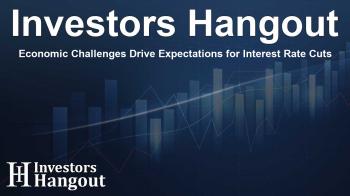Economic Challenges Drive Expectations for Interest Rate Cuts

Understanding the Impact of Trade Policies
Trade policy is shaping the financial landscape as tariffs implemented by the administration have significantly altered economic dynamics. The new levies are reportedly seeing a standard rise of 10 percent on many imports, but certain countries, such as China, are impacted even more severely with tariffs soaring up to 30 percent. This aggressive approach has substantial implications for market stability and inflation rates.
The Ripple Effects of Increased Tariffs
In addition to established tariffs, a recent announcement indicated that imports from countries like India and Brazil face extreme taxes of up to 50 percent. While these measures targeted specific geopolitical tensions, they send ripples through the global trade environment. Moreover, an impending tariff hike on the European Union looms, potentially increasing up to 35 percent if specific investment commitments are not honored. This series of actions elevates the effective tariff rate considerably, reflecting a dramatic shift from earlier in the year.
Challenges in Calculating Economic Growth
Assessing the true impact of these tariffs on both economic growth and inflation poses a challenge due to the intricate web of global trade relations and fluctuating policies. Notably, recent labor statistics showed a downward trend, hinting that the impact of tariffs is starting to manifest in employment data. A significant slowdown was observed in job creation, with significant revisions affecting previously reported figures.
Effects on the Services Sector
As the economic landscape evolves, key concerns arise about how tariffs affect the services sector, accounting for roughly 70 percent of the U.S. GDP. Recent reports have indicated a weakening in the services sector, with rising costs contributing to this effect. As price pressures increase, the ripple effect on services could prove concerning for future economic health.
Federal Reserve’s Dilemma
The Federal Reserve has been navigating a complex path of maintaining interest rates while balancing inflation concerns. After recent meetings, comments from Fed Chair Jerome Powell suggested a cautious approach, observing the health of both the economy and the job market. Despite the economic indicators, the question remains about whether the Fed will act sooner to cut rates as market expectations grow.
Market Reactions to Economic Signals
Recent fluctuations in the equity markets indicate resilience despite tariff-induced uncertainties. Positive earnings reports, particularly from major tech firms, have provided shareholders with hope amid fears of stagnation. Notably, a bulk of corporations reported impressive earnings surprises, signaling a potentially brighter outlook than anticipated.
The Consumer Landscape
Consumer behavior continues to evolve under these economic pressures. With higher prices and increased borrowing levels becoming the norm, reports indicate that consumers are nonetheless maintaining spending habits. However, they are also showing signs of strain, as delinquency rates begin to creep upwards amidst mounting financial pressures.
Indicators of Economic Slowdown
Data from the Institute for Supply Management suggests a contraction in service employment, further emphasizing concerning trends in the economy. The latest figures are disconcerting, showing that while growth persists, the pace is decelerating, raising alarms about inflationary conditions manifesting in the economy.
Future Economic Indicators
Looking ahead, key indicators will be scrutinized closely for hints regarding the economy's trajectory. Scheduled releases of the Producer Price Index and initial jobless claims will provide further insights into market health. August's consumer sentiment and inflation expectations will also play a pivotal role in shaping investor confidence moving forward.
Frequently Asked Questions
What are the new tariffs implemented by the U.S. government?
The U.S. government has implemented new tariffs, with most imports facing a 10 percent levy and certain countries facing significantly higher rates, such as China's 30 percent tariff.
How have these tariffs impacted the economy?
The tariffs have raised concerns regarding economic growth and inflation, causing fluctuations in employment data and economic forecasts.
What is the Federal Reserve’s stance on interest rates?
The Federal Reserve has maintained interest rates but is under pressure to reconsider this stance in light of recent job market data and inflation indicators.
How is the consumer market responding to economic changes?
Consumers are continuing to spend but are increasingly facing pressure from higher prices and greater debt levels, which could impact future consumer behavior.
What should investors watch for in upcoming economic reports?
Investors should pay attention to key reports such as the Producer Price Index and jobless claims to gauge the overall health of the economy and anticipated market movements.
About The Author
Contact Thomas Cooper privately here. Or send an email with ATTN: Thomas Cooper as the subject to contact@investorshangout.com.
About Investors Hangout
Investors Hangout is a leading online stock forum for financial discussion and learning, offering a wide range of free tools and resources. It draws in traders of all levels, who exchange market knowledge, investigate trading tactics, and keep an eye on industry developments in real time. Featuring financial articles, stock message boards, quotes, charts, company profiles, and live news updates. Through cooperative learning and a wealth of informational resources, it helps users from novices creating their first portfolios to experts honing their techniques. Join Investors Hangout today: https://investorshangout.com/
The content of this article is based on factual, publicly available information and does not represent legal, financial, or investment advice. Investors Hangout does not offer financial advice, and the author is not a licensed financial advisor. Consult a qualified advisor before making any financial or investment decisions based on this article. This article should not be considered advice to purchase, sell, or hold any securities or other investments. If any of the material provided here is inaccurate, please contact us for corrections.

